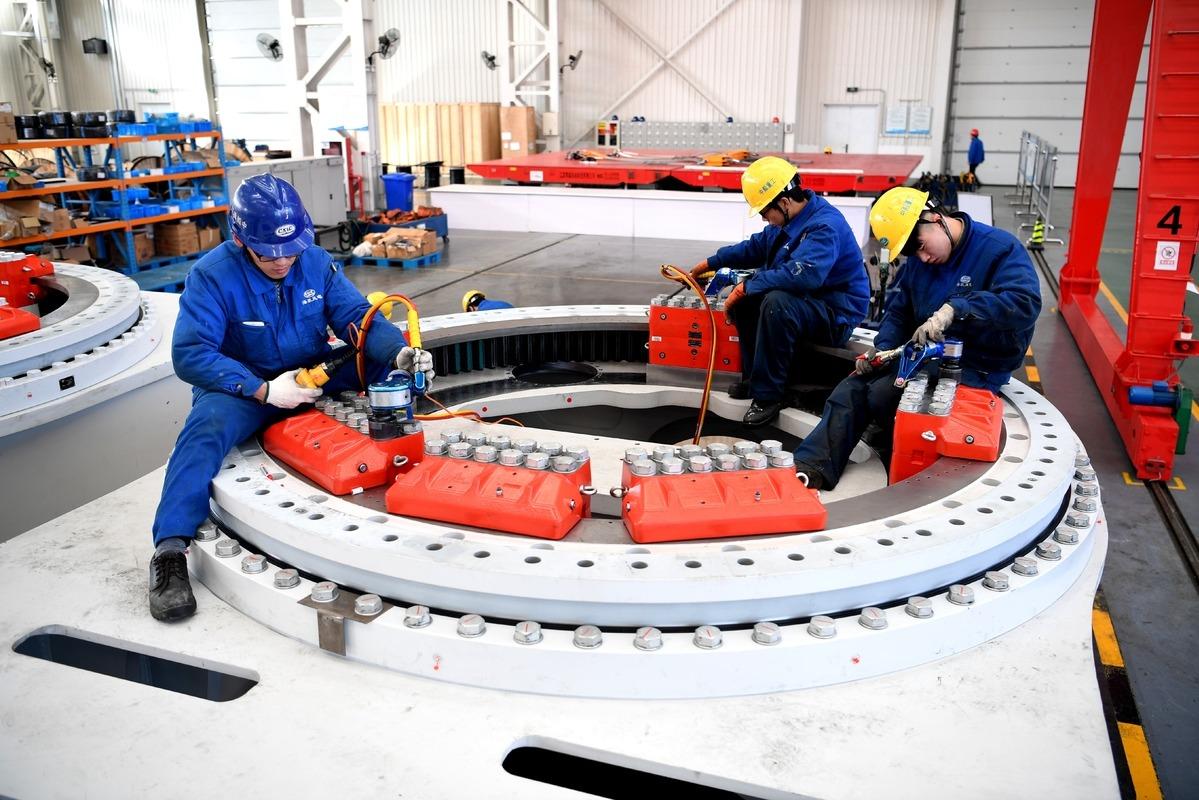 Employees from a subsidiary of China Shipbuilding Industry Corp install clean-energy equipment in Nantong, Jiangsu province. (PHOTO / XINHUA)
Employees from a subsidiary of China Shipbuilding Industry Corp install clean-energy equipment in Nantong, Jiangsu province. (PHOTO / XINHUA)
China's State-owned enterprises plan to invest over 10 trillion yuan ($1.49 trillion) in more than 1,300 "new infrastructure"-related projects across the country during the 14th Five-Year Plan period (2021-25), injecting new impetus into efforts to sustain economic growth, said senior State-asset regulators on Friday.
Unlike traditional infrastructure such as railways, roads and water conservancy, the concept of "new infrastructure" refers to critical facilities based on information technologies like 5G, artificial intelligence, industrial internet and the internet of things.
More than 700 subsidiaries of nearly 70 centrally administered SOEs have expanded their layout in the field of "new infrastructure"-related businesses, with an investment of more than 400 billion yuan in 2021
SOEs will accelerate the pace of reform and innovation, and focus on areas such as industrial security, national economy, people's livelihood and public services to promote the transformation and development of traditional sectors. They will also bolster the growth of emerging industries, said Peng Huagang, secretary-general of the State-owned Assets Supervision and Administration Commission of the State Council.
More than 700 subsidiaries of nearly 70 centrally administered SOEs have expanded their layout in the field of "new infrastructure"-related businesses, with an investment of more than 400 billion yuan in 2021.
Addressing a news conference in Beijing, the official said that backed by China's structural adjustment funds and innovation funds for SOEs, State-owned companies' investment in emerging industries grew from less than 700 billion yuan in 2017 to more than 1.3 trillion yuan in 2021, with an average annual growth rate of more than 20 percent.
SOEs have already established a number of digital innovation platforms like new energy vehicles, the Beidou navigation satellite system, e-commerce and blockchain, as well as collaborative innovation platforms for sectors like offshore engineering equipment, logistics and big data by the end of 2021.
China has been working on an integrated big data system across the country, which involves eight national computing hubs and 10 national data center clusters, the National Development and Reform Commission announced in February.
READ MORE: Pro-growth policies set to stabilize economy
SOEs' investment in "new infrastructure"-related projects will accelerate the integration and application of innovative technologies like artificial intelligence and big data with real economy, and support the digital transformation of small and medium-sized enterprises, said Liu Xingguo, a researcher at the China Enterprise Confederation in Beijing.
He said it will not only create a more physical workload and new businesses in the coming years, but also generate business orders in both upstream and downstream areas in advance, and stabilize the expectations of SMEs.
Weng Jieming, vice-chairman of the SASAC, said that in the next step, the government will focus on deepening the supply-side structural reform and building world-class enterprises to further promote strategic restructuring and professional integration of central SOEs.
China had completed the reorganization of 47 central SOEs such as China Railway Rolling Stock Corp and China COSCO Shipping Corp Ltd during the 2012-21 period, while establishing new central SOEs, including China Oil & Gas Pipeline Network Corp and China Anneng Construction Group Corp.
Apart from making contributions to the growth of the Belt and Road Initiative, the overseas assets of central SOEs have reached nearly 8 trillion yuan to date, with over 8,000 projects in more than 180 countries and regions, Weng said.
ALSO READ: Trade expansion in 2022 to deepen resilience
Constructed by China Road and Bridge Corp, a subsidiary of Beijingheadquartered China Communications Construction Co Ltd, the Nairobi Expressway in Kenya, linking Jomo Kenyatta International Airport to the city's downtown district, opened for trial operations last month.
Once fully operational, travel time between the airport and downtown Nairobi will be shortened to 20 minutes, said Li Changgui, CRBC's vicepresident.
"It is expected to help relieve traffic pressure in Nairobi, improve the city's international image, and create job opportunities while promoting Kenya's economic growth and helping the country evolve into economic and cultural center of East Africa," he said.


